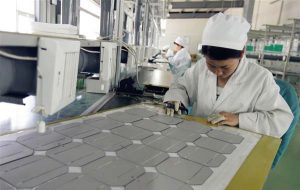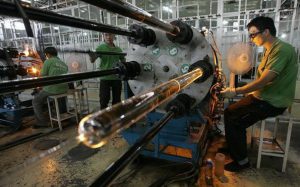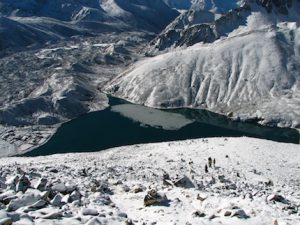Olivia Boyd (OB): China has driven costs of solar power down dramatically, but new research suggests that’s come at an environmental cost. Can the industry clean up?
Stephen Markscheid (SM): I’m perfectly willing to believe the study but I see it as being kind of irrelevant because people only really care about financial cost. If people cared about the environmental impact of manufacturing solar panels, we’d have a carbon tax.
China has its own environmental regulations and solar companies are committed to abide by those. In terms of going beyond that, that seems to be a recipe for failure in that solar panels are effectively a commodity and if you take on greater costs then you make yourselves uncompetitive.
We had this crisis four years ago. With the market growing rapidly globally, Chinese manufacturers said we want to grow our share, so let’s build up capacity, until in 2011-12 we ended up in a world with 30GW of demand and 60GW of supply. Prices fell from above 2 dollars a watt down to about 60 cents, and everybody lost money.
So going above and beyond what’s required to reduce your carbon footprint to be more environmentally responsible in the manufacturing process is a luxury that Chinese manufacturers don’t feel they can afford.
OB: The US has just announced new tariffs on Chinese-made solar panels as the latest move in an escalating solar trade war. What’s the impact?
SM: Look at the share prices of all the Chinese manufacturers – they all fell by 5-10% [after the announcement]. The United States (US) manufacturers First Solar and Sunpower are way up. So I think it impedes the adoption of solar power and it’s a sad thing.
For the last year or so we’ve had a tariff on Chinese solar cells. What it means is that all the Chinese panels that are coming to the US, they make their ingots and wafers [solar panel components] in mainland China, then ship the wafers to Taiwan for cell manufacturing, then bring them back to China to put them in the modules. So the tariff is just silly. It doesn’t make any money for the US government and it just enriches the Taiwan-based solar manufacturers and blunts the adoption of solar in the US.
When you think about whether you make panels in the US, China or Europe and which is more environmentally friendly, I think the impact of that is really dwarfed by the way that parochial business interests are hurting the environment.
OB: What’s the resolution?
SM: There are discussions going on between Chinese industry groups and the US government, as well as the two industry associations in the United States, about trying to find a negotiated settlement. I think there’s a deal to be done and maybe it involves a subsidy to help the American manufacturers survive. But it just seems to me it is a commodity, and you have to be cost-effective. And if it’s more cost effective to make panels in China, then what’s the problem with that?
When we saw the first round of tariffs two years ago, I thought it was too bad that the Chinese industry didn’t partner more effectively with all the downstream solar companies in the US because the notion that Chinese manufacturers are stealing jobs from American manufacturers of solar panels is kind of laughable when there’s so much more employment to be had downstream in the installation of solar panels on rooftops.
OB: Why has the Chinese solar PV market been so export oriented?
SM: The bigger picture is that the dominant technology for solar electricity is photovoltaic, it’s 60-year-old technology, and for 50-plus years of that history it was just really expensive – $8-10 a watt, and a niche market for German and Japanese companies. Then 15 years ago Europe instituted feed-in-tariffs and the market started to grow, even from a low base and an expensive one.
The Chinese took a look at it and said ‘we can do that’, and maybe a dozen solar companies listed on the New York stock exchange and raised enough capital to really drive down costs. For a long time we were wondering at what point China would institute feed-in-tariffs to try to encourage more domestic solar electricity production. And two years ago, they ramped up their own polysilicon manufacturing, and they did it through feed-in-tariffs.
Three or four years ago, Europe was 70-80% of the global market for solar panels, now it’s down to 20% and China last year for the first year was the largest market with about 8GW. We’re looking at 12 to 14GW this year. So China is serious about this. Just as it’s been the largest wind market for some time, it’s now the largest solar market as well.
OB: Do you see it as an innovative sector, beyond price innovation?
SM: No. We’re dealing with 60 year old technology. There’s tinkering at the margins, everyone likes to say they’re differentiated, but really these panels are all pretty interchangeable. People come to me all the time and say ‘I have a start-up company with this new wind technology or solar technology, wouldn’t your Chinese wind or solar company want to partner and help develop this?’ And it seems to me no – I think that Chinese companies are not very good at commercialising new technology, what they excel at is optimising traditional technology and largely that means squeezing out costs. There’s a lot of interesting stuff going on both with wind and solar, but I think relatively little of it is happening in China, and generally not among the large listed manufacturers.
OB: Do you expect greater support for solar PV in China’s next Five-Year Plan?
SM: They’ve just upped their estimates. For a long time China has had a target of 35GW cumulative installation by 2015, and they seem to be on track for that. Now they’re talking about 70GW by the year 2020. I think it’s going to be more and more.
I’m pretty impressed with what they’ve done, first with the feed-in-tariff and now other incentives. That’s why China’s solar market has jumped from being small to being quite large. There’s an issue with the distributed generation target though. Originally for this year China was targeting 12GW of solar – that was the State Council target – but then the National Electricity Administration said, by the way 60% of it has to be distributed generation, meaning rooftops and towards the eastern population centres. That’s an awful lot to do in one year because it’s much easier putting solar panels up in the desert in Xinjiang than figuring out how to do all this rooftop stuff. We kind of expect them to relax that 60% target because it’s totally unrealistic.
OB: Do you think the sector is stronger now, or is it only a matter of time until the next crisis?
SM: One of the differences is that the global market is so much better balanced. It’s not just dependent on Europe. Japan has gotten huge in the wake of Fukushima, America continues to grow and so does China. It’s a tough business – the share price is volatile, the price is volatile – but it’s possible to succeed if you are really tightly managed.
Former banker Stephen Markscheid is independent director on the boards of Chinese renewable energy companies Jinko Solar and China Ming Yang Wind Power Group. His comments represent his personal views.






